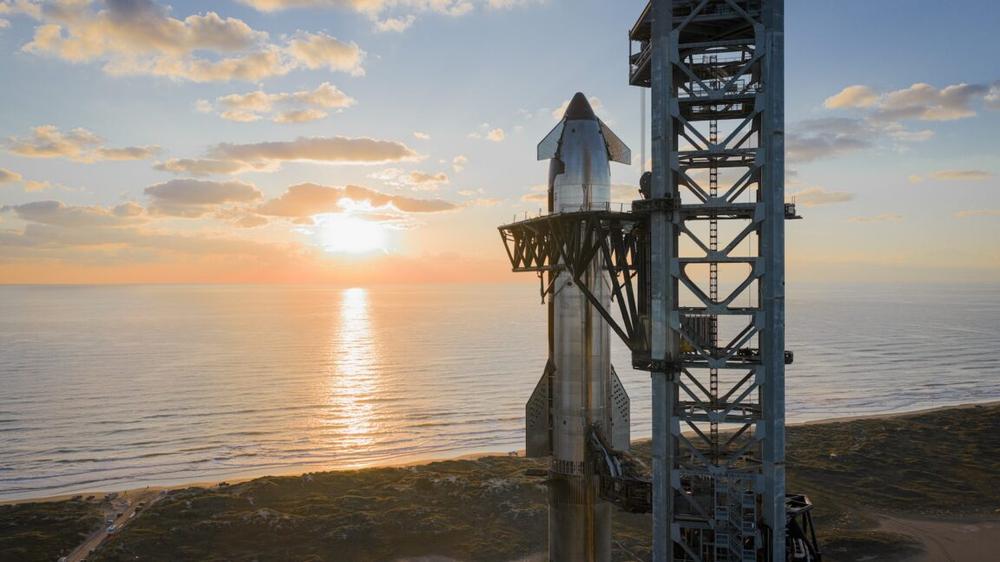SpaceX is set to launch the 11th full-scale test flight of the company's Starship rocket Monday evening, with hopes of capping a tumultuous year with a successful one-hour voyage from South Texas to the Indian Ocean.
Liftoff of the Super Heavy booster with the Starship upper stage is scheduled for 6:15 pm CDT (7:15 pm EDT; 23:15 UTC). SpaceX has a 75-minute window to launch Monday. You can watch a livestream of the flight here.
SpaceX's control team, positioned a couple of miles away from the launch pad at Starbase, Texas, will oversee the loading of more than 10.5 million pounds of super-cold methane and liquid oxygen into the two-stage rocket beginning about an hour before liftoff. In the final minutes of the countdown, the world's largest rocket will undergo a steering check, and the launch director will give a final "go" for launch.
The booster's 33 Raptor engines will ignite to push the massive stainless-steel rocket skyward with approximately 16.7 million pounds of thrust, 60 percent more power than the Soviet N1, the second-largest rocket in history. This is the second time SpaceX will use a previously flown Super Heavy booster. This particular booster launched and landed on a Starship test flight in March.
What’s different?
Much of this flight will seem familiar to anyone who watched the previous Starship mission in August. The 403-foot-tall (123-meter) rocket will follow an arcing trajectory over the Gulf of Mexico before shedding its Super Heavy booster a little more than two-and-a-half minutes into the flight. A split-second before staging, the six engines on the Starship upper stage will fire to continue the push into space.
On the descent back to Earth, the booster stage will test a new landing burn engine configuration SpaceX plans to use on the next version of the rocket. The new sequence will use 13 of the booster's 33 engines, then downshift to five engines before running just the three center engines for the final phase of the burn. This "13-5-3" sequence will make the rocket more resilient against an engine failure, SpaceX said. Previously, the booster transitioned directly from 13 engines to three engines.
"The primary goal on the flight test is to measure the real-world vehicle dynamics as engines shut down while transitioning between the different phases," SpaceX said.
The booster won't return to Starbase for a catch by the launch pad's tower arms. Instead, it will target a splashdown offshore in the Gulf.
Once in space, Starship will deploy eight Starlink satellite simulators, just as it did on the last flight. The dummy satellites will follow the same suborbital path as Starship and will burn up in the atmosphere over the Indian Ocean. The ship will also restart one of its Raptor engines for a brief maneuver to fine-tune its trajectory toward reentry.
Perhaps the most critical part of Monday's mission will come in the final minutes of the test flight. An important goal of SpaceX engineers is to test the ship's heat shield, just as it has been for all of the company's Starship flights this year. But the first three Starship flights of the year failed to make it to reentry. Finally, in August, Flight 10 saw the ship sail through a successful launch and reentry, culminating in a pinpoint splashdown northwest of Australia.
Engineers learned a few things about the Starship heat shield. One of the lessons was that the company's experiment to replace some of the ship's ceramic tiles with metallic insulators didn't work as expected. On this flight, SpaceX has removed tiles from certain places on Starship to "intentionally stress-test vulnerable areas" of the vehicle. The company said some of the missing tiles are in areas where the tiles are bonded directly to the ship's stainless-steel skin and do not have a backup ablative layer.
SpaceX is searching for the right tile design to help the rocket better withstand the rigors of reentry, when temperatures reach 2,600° Fahrenheit (1,430° Celsius), producing a sheath of orange and purple plasma as the ship dives through the atmosphere. The ultimate goal is for SpaceX to rapidly reuse Starship without refurbishment. While several Starships have survived reentry, none have come down in the pristine condition required for rapid reuse.
Future flights of Starship will end with returns to Starbase, where the launch tower will try to catch the vehicle coming home from space, similar to the way SpaceX has shown it can recover the Super Heavy booster. A catch attempt with Starship is still at least a couple of flights away.
In preparation for future returns to Starbase, the ship on Flight 11 will perform a "dynamic banking maneuver" and test subsonic guidance algorithms prior to its final engine burn to brake for splashdown. If all goes according to plan, the flight will end with a controlled water landing in the Indian Ocean approximately 66 minutes after liftoff.
Turning point
Monday's test flight will be the last Starship launch of the year as SpaceX readies a new generation of the rocket, called Version 3, for its debut sometime in early 2026. The new version of the rocket will fly with upgraded Raptor engines and larger propellant tanks and have the capability for refueling in low-Earth orbit.
Starship Version 3 will also inaugurate SpaceX's second launch pad at Starbase, which has several improvements over the existing site, including a flame trench to redirect engine exhaust away from the pad. The flame trench is a common feature of many launch pads, but all of the Starship flights so far have used an elevated launch mount, or stool, over a water-cooled flame deflector.
The current launch complex is expected to be modified to accommodate future Starship V3s, giving the company two pads to support a higher flight rate.
NASA is counting on a higher flight rate for Starship next year to move closer to fulfilling SpaceX's contract to provide a human-rated lander to the agency's Artemis lunar program. SpaceX has contracts worth more than $4 billion to develop a derivative of Starship to land NASA astronauts on the Moon.
But much of SpaceX's progress toward a lunar landing hinges on launching numerous Starships—perhaps a dozen or more—in a matter of a few weeks or months. SpaceX is activating the second launch pad in Texas and building several launch towers and a new factory in Florida to make this possible.
Apart from recovering and reusing Starship itself, the program's most pressing near-term hurdle is the demonstration of in-orbit refueling, a prerequisite for any future Starship voyages to the Moon or Mars. This first refueling test could happen next year but will require Starship V3 to have a smoother introduction than Starship V2, which is retiring after Flight 11 with, at best, a 40 percent success rate.

 #ITALIA 🇮🇹 #20cent
#ITALIA 🇮🇹 #20cent